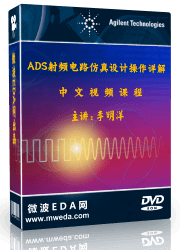- 易迪拓培训,专注于微波、射频、天线设计工程师的培养
How to match momentum simulation with schematic simulation result?
Hello,
I am designing a simple open stub filter which suppresses 2nd and 3rd harmonic frequency and gives a required value of Zin at the operating frequency (or first harmonic) using two quarter wave open stubs designed at 2nd and 3rd harmonic frequency respectively. The schematic has 8 parameters, which I can TUNE to get the desired response.
The problem arises after doing moemtum simulation,the result is almost matching at the lower frequency band but not at the higher frequencies.....dips are shifted and Zin at fundamental freq also slightly detuned.
I have tried to match the momentum result with the schematic response using OPTIMIZATION, but it can't achieve what I want and importantly, it takes huge time.
What is the process to match the momentum simulation resultswith the schematic exactly in less number of steps?
Are you using your Momentum results in schematic with symbol + emModel?
If you look at emModel settings, there is one tab for interpolation. You can use interpolation for the stub length, so that small changes in stub length are evaluated by interpolation instead of starting another EM run. THis can speed up your EM-based optimization.
Good luck!
Volker
I first simulated and optimized the schematic and generatedlayout from that optimized schematic. I also tried to optimize the momentum result with the goals being that final optimized schematic result. (as shown in the picture below)....but the momentum optimization is takinglong time and it doesn't match with the desired goal after hundreds of iteration.

Is there any "faster" way to match the momentum result with the optimized schematic result?
Consider emModel interpolation which I recommended above. If you open the emModel settings, you will find the interpolation tab. Use meaningful values.
I have run for 19 hrs and only 76 iterations are finished...very very slow! Even after 76 iterations, the result is not matching with the opmised schematic
Have you tried my suggested solution? I try to avoid direct EM optimization and prefer more efficient methods like pertubation technique, but your trivial case should work fine. It seems that your model isn't meshed efficiently.
Don't expect full agreement between circuit simulation and EM. We do EM because it is more accurate (if done properly) and includes coupling effects that are missing in model-based circuit simulation (nodal connection only).
Good luck!
Yes, after enabling the interpretation option with default interpretation range it became much slower.
I have enabled the edge mesh and transmission line mesh.
Could you please elaborate on the perturbation process that you use?
I don't know what you did with emModel interpolation - for my EM work that uses interpolation, it becomes much faster because many EM simulations can be skipped and instead interpolated data is used. However, it is mandatory to use good meaningful values for the "Interpolation Delta".

For pertubation technique, you might search for work by Dan Swanson or Jim Rautio. "Port tuning" is another keyword.
Applied to this case, you would set up a multi-port model where you cut of the very last segment of the open ended stub, and place a port there. Then, use the multi-port emModel in schematic and connect an open ended stub circuit model. You then have 95% of the model EM-simulated, and can tune the residual (very short) open ended stub length delta_l at circuit simulation speed. Then, iteratively include the resulting length delta_l (plus or minus) into the EM part. For the line between the stub, same idea: cut out a small length and place ports, then attach an MLIN in schematic so that you can fine tune the +/- length at circuit simulation speed.
It's difficult to describe, but there is a lot of literature on that topic from the last 10 years or so. This technique has become quite popular with filter designers.
申明:网友回复良莠不齐,仅供参考。如需专业帮助,请学习易迪拓培训专家讲授的ADS视频培训课程。
上一篇:Linecalc simulation not showing error messages
下一篇:plotting help
ADS涓枃瑙嗛鍩硅鏁欑▼ | More...
 国内最全面、最专业的Agilent ADS培训课程,可以帮助您从零开始,全面系统学习ADS设计应用【More..】
国内最全面、最专业的Agilent ADS培训课程,可以帮助您从零开始,全面系统学习ADS设计应用【More..】
- Agilent ADS教学培训课程套装
- 两周学会ADS2011、ADS2013视频教程
- ADS2012、ADS2013射频电路设计详解
- ADS高低阻抗线微带滤波器设计培训教程
- ADS混频器仿真分析实例视频培训课程
- ADS Momentum电磁仿真设计视频课程
- ADS射频电路与通信系统设计高级培训
- ADS Layout和电磁仿真设计培训视频
- ADS Workspace and Simulators Training Course
- ADS Circuit Simulation Training Course
- ADS Layout and EM Simulation Training Course
- Agilent ADS 内部原版培训教材合集









 沪公网安备 31011202014168号
沪公网安备 31011202014168号
 1427313829
1427313829 旺旺在线
旺旺在线 Skype Online
Skype Online 13761612886
13761612886 官方淘宝店
官方淘宝店
